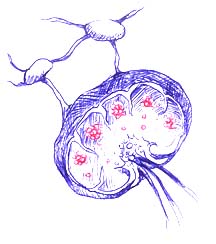The Reality of Lymphoma Cancer
Lymphoma is a type of cancer that begins in the lymphocytes – the infection-fighting cells in the immune system. There are two types of lymphoma called HODGKIN’S LYMPHOMA and NON-HODGKIN’S LYMPHOMA.

REALITY CHECK
There were 776 cases of lymphoma diagnosed in 2007 and registered at the Malaysian National Cancer Report, comprising of 448 males and 328 females. The incidence of lymphoma was slightly higher among males compared to females. The Chinese were found to have higher incidence rate compared to Malays and Indians.
Common Types of Lymphoma cancer
HODGKIN’S LYMPHOMA
In Hodgkin’s lymphoma, a particular type of lymphocyte called B-lymphocytes begins to abnormally multiply and cluster in some parts of the lymphatic system. These infected lymphocytes lose their ability to fight infections, thus weakening the immune system and leaving you vulnerable to infections. Hodgkin’s lymphoma could often be diagnosed before it reaches an advanced stage as it progresses step by step. They are more likely to arise in the neck, underarms, or chest. During examination, if the doctor detects a specific type of abnormal cell known as ‘Reed-Sternberg cell’, then the lymphoma will be classified as Hodgkin’s.
NON-HoDGKIN’S LYMPHOMA
Non-Hodgkin’s lymphoma is more common than Hodgkin’s lymphoma. It can arise in lymph nodes throughout the body and often only detected at the advanced stage. The cancer cells are examined under a microscope, and if the ‘Reed-Sternberg cell’ is not present, the lymphoma is classified as non-Hodgkin’s.
Staging and Grading
Once you have been diagnosed positive for cancer after a biopsy test, the condition will be given a stage and grade. This vital information will help you and your healthcare team to choose the best treatment for you. The cancer stage will describe the size of the tumour and how far it has spread.
There are 4 stages for lymphoma cancer:
Stage 1
- The cancer cells are in one lymph node group such as in the neck or underarm
- If the abnormal cells are not in the lymph nodes, they are in only one part of a tissue or organ
Stage 2
- The cancer cells are in at least two lymph node groups, on the same side of the diaphragm
- Or, the cells are in one part of a tissue or an organ and the lymph nodes near that organ are on the same side of the diaphragm
- Cancer cells may be in other lymph node groups on the same side of the diaphragm
Stage 3
- The cancer cells are in lymph nodes on both sides of the diaphragm
- Cancer cells may also be found in one part of a tissue or an organ near these lymph node groups
Stage 4
- The cancer cells are found in lymph nodes and several parts of one or more organs or tissues
- Or, it has spread to the liver, blood, or bone marrow
There are 4 grades of lymphoma cancer:
Grade 1 – The cells look normal and tend to be slow-growing.
Grade 2 – Most intermediate lymphomas are treated as aggressive even though they grow less rapidly. Some of these types are curable.
Grade 3 and 4 – These cells grow very rapidly and require a more aggressive therapy approach.
WARNING SIGNS
- Swollen lymph nodes
- Night sweats
- Fatigue
- Unexplained weight loss
- Itch and rashes
- Fever
- Infections that are difficult to shake off
AM I AT RISKS?
Yes, even more so with these factors:
- Contracted certain infections
- Previously undergone treatment for cancer
- Lifestyle, eating habits, smoking and drinking
- Exposure to certain chemicals or radiation
THERE ARE RISK FACTORS THAT CAN'T BE CHANGED
- Immune system complications
- Air pollution
- Personal or family history of lung cancer or lymphoma
- Gender and ethnicity
- Aging
WHAT CAN I DO?
Beat the cancer. Cut your risk by taking these steps:
- Treat infections quickly
- Do not smoke and drink
- Avoid radiation and toxins
- Practice safe sex to avoid contracting infections
Lymphoma Cancer Myths Vs Facts
Myth |
Fact |
| Treatment for cancer is always chemotherapy | There are modern oral medications being used in place of chemo radiation. |
| I have lymphoma cancer, treatments can’t save me | Today, there is a better understanding of molecular biology between lymphoma and its subtypes. Specific markers linked to specific subtypes of lymphomas can be identified and the new drugs available truly targets to kill cancer cells. In general, lymphoma treatment can be tolerated by many people and it’s very effective. |






